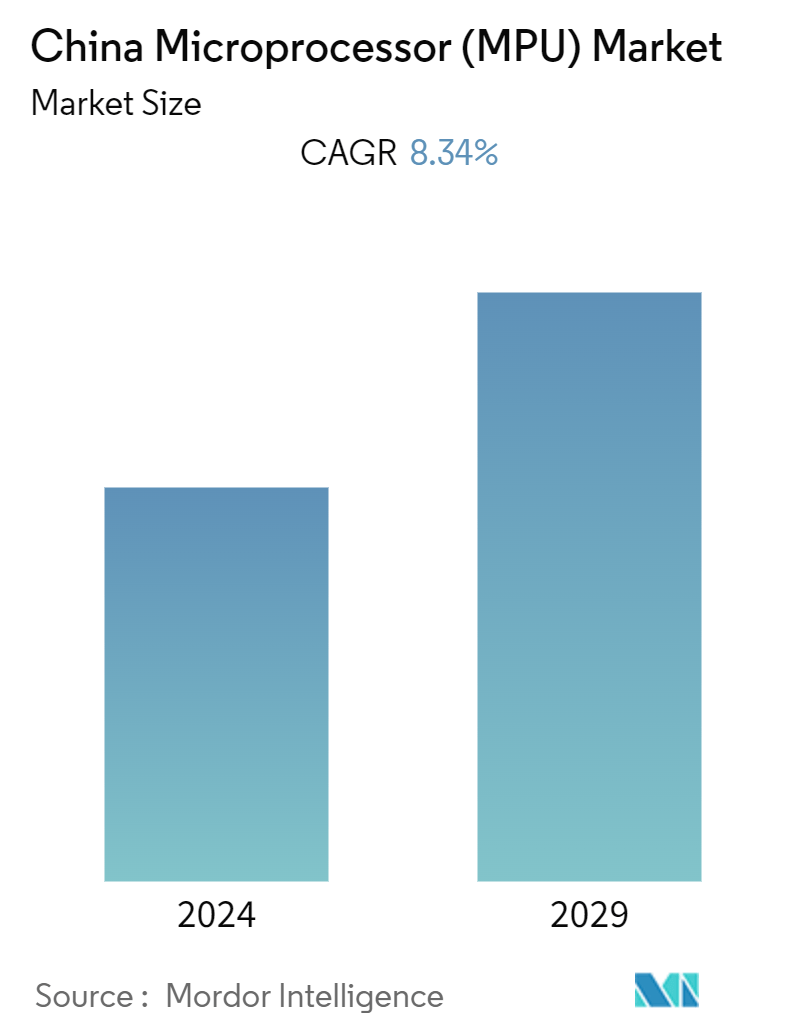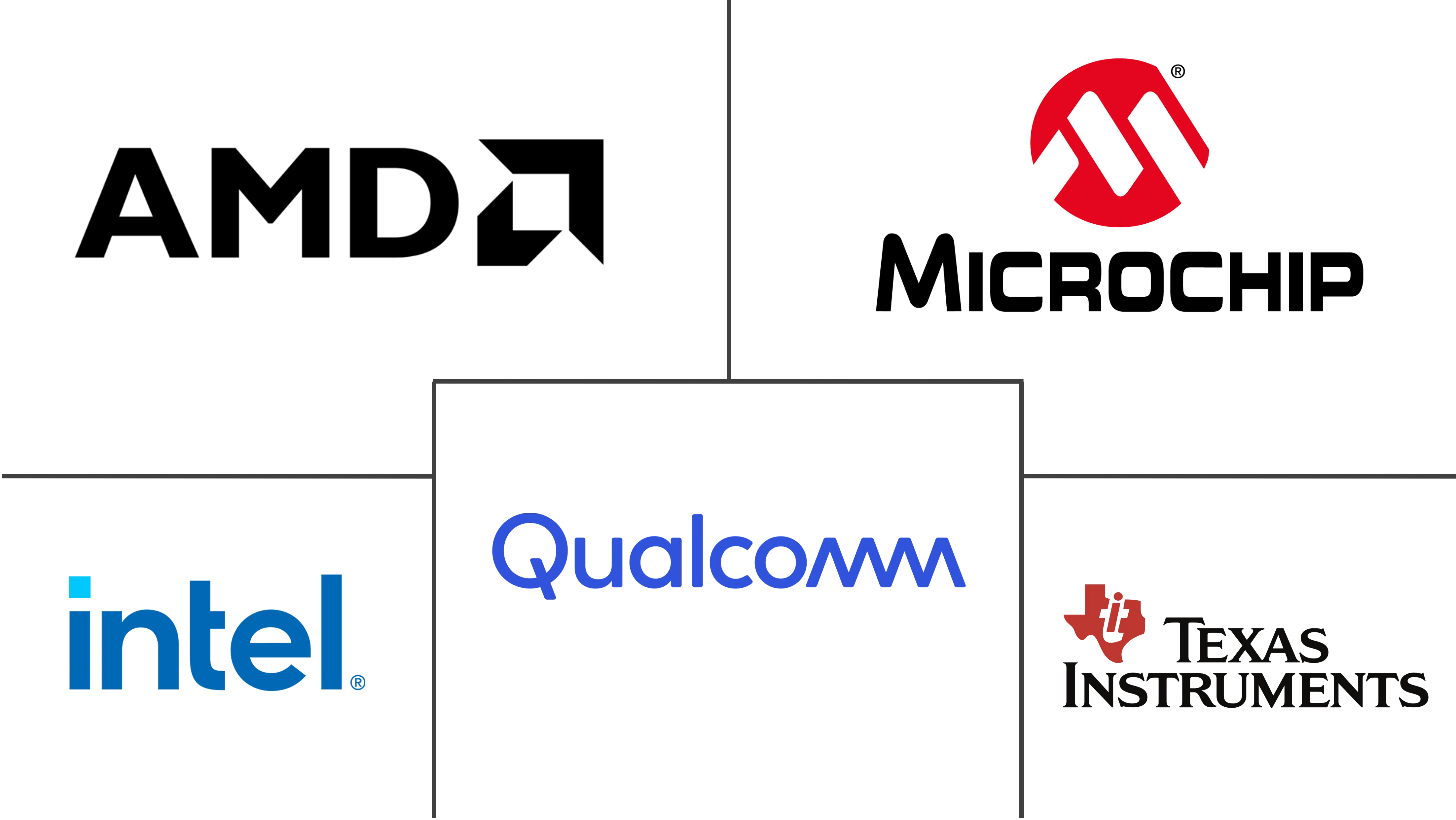Market Size of China Microprocessor (MPU) Industry

| Study Period | 2019 - 2029 |
| Base Year For Estimation | 2023 |
| Forecast Data Period | 2024 - 2029 |
| Historical Data Period | 2019 - 2022 |
| CAGR (2024 - 2029) | 8.34 % |
| Market Concentration | Low |
Major Players
*Disclaimer: Major Players sorted in no particular order |
China Microprocessor (MPU) Market Analysis
The China Microprocessor Market is expected to register a CAGR of 8.34% during the forecast period.
The Chinese microprocessor (MPU) market was valued at USD 9.87 billion in the current year. It is expected to reach USD 16.51 billion, registering a CAGR of around 8.34% during the forecast period. The market is expected to witness an increase in demand at the global level owing to the growing use of microprocessors in consumer electronics, such as smartphones, personal computers (PC), and laptops.
- China is assisting the market's growth due to a number of factors, including an increase in digitization, a rise in the use of high-tech devices, and the development of automotive electronics, among others. Additionally, it is anticipated that rising cloud service demand, massive government IT spending, and increased Internet of Things (IoT) usage are expected to support market expansion in China.
- China is taking advantage of the chance to increase its level of microprocessor self-sufficiency and end the US and British companies' monopolies. The most recent effort by China to increase its chip self-sufficiency has focused on microprocessors, the brains of all modern electronics. Since 2022, an increasing number of Chinese chip design companies have substituted open-source RISC-V for Intel's proprietary X86 and Arm's architecture in their chip designs in an effort to reduce the potential harm from US sanctions and save money on licensing fees.
- Chinese internet companies like Alibaba and Baidu have been manufacturing their chips. This is seen as progress toward China's goal of boosting domestic technological capacity. Due to ongoing trade issues and geopolitical considerations, China is working toward chip and semiconductor self-sufficiency. In its 14th five-year plan, China identified seven technological sectors, including artificial intelligence, quantum computing, semiconductors, and space.
- Additionally, a number of new companies in China are rushing into the semiconductor industry, according to Semiconductor Industry Association. Chinese companies registered as semiconductor enterprises number almost 15,000. Many of these new businesses are fabless start-ups with a focus on higher-end chip design, such as GPU, EDA, FPGA, and AI computing. Many companies create cutting-edge chips and design and manufacture devices using cutting-edge process nodes.
- According to SIA projections released in November 2022, China's market share of global chip design will increase from 9% in 2020 to 23% by 2030 (compared to a US decline from 46% to 36%), a significant rise but still far from world-beating. The development of chip design will soon enable Chinese businesses to grow. Such growth is likely to boost the Chinese microprocessor (MPU) market.
- On the other hand, it is anticipated that over the upcoming years, factors like high raw material prices, declining shipments of individual computers, rising sales of low-cost mobile devices, high manufacturing costs for microprocessor integrated circuits, and low-priced mobile device shipments will impede the market growth.
China Microprocessor (MPU) Industry Segmentation
A microprocessor is an electronic component integrated into a single integrated circuit (IC) containing millions of small components that work together, such as diodes, transistors, and resistors. This chip performs a variety of functions, including timing, data storage, and interaction with peripheral devices. These integrated circuits are found in a wide range of electronic devices, including servers, tablets, smartphones, and embedded devices.
The Chinese microprocessor (MPU) market is segmented by product (8-bit, 16-bit, and 32-bit or greater) and by application (consumer electronics, enterprise - computers and servers, automotive, industrial, and other applications). The market sizes and forecasts are provided in terms of value (USD) for all the above segments.
| By Product | |
| 8-bit | |
| 16-bit | |
| 32-bit or Greater |
| By Application | |
| Consumer Electronics | |
| Enterprise - Computers and Servers | |
| Automotive | |
| Industrial | |
| Other Applications |
China Microprocessor (MPU) Market Size Summary
The Chinese microprocessor (MPU) market is poised for significant growth, driven by increasing digitization, the proliferation of high-tech devices, and advancements in automotive electronics. The demand for microprocessors is expected to rise globally, fueled by their essential role in consumer electronics such as smartphones, personal computers, and laptops. China's strategic focus on enhancing microprocessor self-sufficiency aims to reduce reliance on foreign companies, particularly in light of ongoing trade tensions and geopolitical challenges. This effort is supported by the country's robust investment in technological sectors like artificial intelligence, quantum computing, and semiconductors, as outlined in its five-year plans. The shift towards open-source architectures like RISC-V by Chinese chip design companies further underscores this strategic pivot, aiming to mitigate the impact of US sanctions and reduce licensing costs.
The market landscape is characterized by a surge in domestic semiconductor companies, with thousands of new entrants focusing on advanced chip design. This influx is expected to bolster China's market share in global chip design significantly. The rise in consumer demand for smartphones and tablets, coupled with the increasing integration of microprocessors in smart devices, is anticipated to drive market expansion. Additionally, the automotive sector's growing reliance on microprocessors for advanced driver-assistance systems (ADAS) and infotainment systems presents further opportunities for market growth. Despite challenges such as high raw material costs and competition from low-cost mobile devices, China's microprocessor market is set to benefit from substantial government support and strategic industry initiatives, positioning it as a key player in the global semiconductor landscape.
China Microprocessor (MPU) Market Size - Table of Contents
-
1. MARKET INSIGHTS
-
1.1 Market Overview
-
1.2 Industry Attractiveness Porter's Five Forces Analysis
-
1.2.1 Bargaining Power of Suppliers
-
1.2.2 Bargaining Power of Buyers
-
1.2.3 Threat of New Entrants
-
1.2.4 Threat of Substitutes
-
1.2.5 Intensity of Competitive Rivalry
-
-
1.3 Macro-economic Analysis
-
-
2. MARKET SEGMENTATION
-
2.1 By Product
-
2.1.1 8-bit
-
2.1.2 16-bit
-
2.1.3 32-bit or Greater
-
-
2.2 By Application
-
2.2.1 Consumer Electronics
-
2.2.2 Enterprise - Computers and Servers
-
2.2.3 Automotive
-
2.2.4 Industrial
-
2.2.5 Other Applications
-
-
China Microprocessor (MPU) Market Size FAQs
What is the current China Microprocessor (MPU) Market size?
The China Microprocessor (MPU) Market is projected to register a CAGR of 8.34% during the forecast period (2024-2029)
Who are the key players in China Microprocessor (MPU) Market?
Advanced Micro Devices (AMD), Inc., Microchip Technology Inc., Intel Corporation, Qualcomm Technologies Inc. and Texas Instruments are the major companies operating in the China Microprocessor (MPU) Market.

